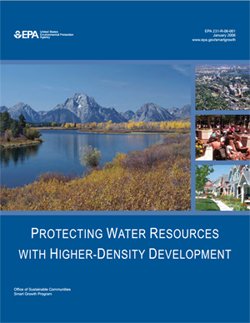Protecting Water Resources with Higher-Density Development

Protecting Water Resources with Higher Density Development (pdf) (2006) is a guide intended to help communities better understand the impacts of high- and low-density development on water resources.
While growth and development can bring resources, amenities, and opportunities, with these benefits come challenges. The environmental impacts of development can make it more difficult for communities to protect their natural resources. Where and how communities accommodate growth profoundly affects the quality of streams, rivers, lakes, and beaches. Development that uses land efficiently and protects undisturbed natural lands lets a community grow and still protect its water resources.
Some communities have interpreted water quality research to mean that low-density development will best protect water resources. However, some water quality experts argue that this strategy can backfire and actually harm water resources. Higher-density development, they believe, is a better way to protect water resources.
EPA modeled scenarios of different densities at three scales and at three different time-series build-out examples to examine whether lower-density development is always better for water quality. EPA examined stormwater runoff from different development densities at the one-acre, lot, and watershed levels to determine the differences among scenarios. This analysis demonstrated:
- Higher-density scenarios generate less stormwater runoff per house at all scales and at all time-series build-out examples.
- For the same amount of development, higher-density development produces less runoff and less impervious cover than low-density development.
- For a given amount of growth, lower-density development affects more of the watershed.
Taken together, these findings indicate that low-density development might not always be preferable for protecting water resources. Higher densities might better protect water quality, especially at the lot and watershed levels. Denser developments consume less land to accommodate the same number of houses. Consuming less land creates less impervious cover in the watershed.
Increasing development densities is one strategy communities can use to minimize regional water quality impacts. To fully protect water resources, communities need to employ a wide range of land use strategies that are based on their local conditions, context, and goals. Such strategies could include building a range of development densities, incorporating adequate open space, preserving critical ecological and buffer areas, and minimizing land disturbance..
Learn more about smart growth and water resources.
